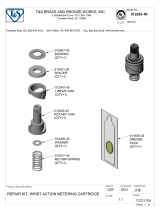
OWNER’S MANUAL
Page - 1 -
CONTENTS
1. NOTE----------------------------------------------------------------------------------
2
2. LIMITED WARRANTY------------------------------------------------------------
2
3. PASSPORT DATA-----------------------------------------------------------------
3
4. TEST PROTOCOL----------------------------------------------------------------
4
5. GENERAL DESCRITION OF THE MACHINE-----------------------------
7
GENERAL DATA-------------------------------------------------------------------- 7
BASIC TECHNICAL DATA-------------------------------------------------------
9
6. DESCRIPTION FO THE MAIN UNITS---------------------------------------
10
GEAR BOX--------------------------------------------------------------------------
10
QUADRANT-------------------------------------------------------------------------
10
FEED BOX--------------------------------------------------------------------------- 10
CARRIAGE GROUP--------------------------------------------------------------- 10
THREAD INDICATOR------------------------------------------------------------- 11
TAIL STOCK-------------------------------------------------------------------------
11
RESTS--------------------------------------------------------------------------------
11
7. MACHINE INSTALLATION------------------------------------------------------
12
TRANSPORTATION--------------------------------------------------------------- 12
UNPACKING------------------------------------------------------------------------- 12
HANDLING--------------------------------------------------------------------------- 12
PREPARATION---------------------------------------------------------------------
12
MOUNTING, FOUNDATIONS AND LEVELLING--------------------------- 12
CONNECTION TO THE EL. SUPPLY SOURCE-------------------------- 13
PUTTING INTO OPERATION--------------------------------------------------- 13
8. MACHINE SERVICE--------------------------------------------------------------
15
LUBRICATION---------------------------------------------------------------------- 15
RECOMMENDED LUBRICANTS---------------------------------------------- 16
9. MACHINE OPERATION----------------------------------------------------------
17
PUTTING INTO OPERATION--------------------------------------------------- 17
CUTTING OF THREAD AND FEEDS----------------------------------------- 17
FRETTED PARTS------------------------------------------------------------------ 20
10. MECHANISM’S ADJUSTMENT------------------------------------------------
21
11. SAFETY------------------------------------------------------------------------------
21
12. MACHINE CARE AND MAINTENANCE-------------------------------------
22
13. TRANSMISSION SYSTEM & PARTS----------------------------------------
23
14. BEARING DISTRIBUTION------------------------------------------------------
26





















